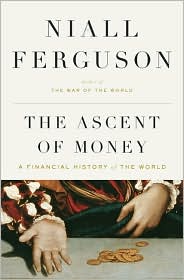Book
The book deals with the rise of money as a trade form, and tracks its progression, development, and effects on society into the 21st Century. It also covers the importance of financial systems and the role they have played throughout historical events. In total there are six chapters covering various financial events along with an introduction and an afterword note included at the end. Each chapter covers a different aspect of the financial system.
Chapter one depicts the journey of Francisco Pizarro, a Spanish explorer, as an example of the establishment of gold and silver being used as currency. It also discusses the beginning of lending, or credit, and finally moving on to the foundational pieces of modern banking through the story of the Bank of England in the 19th century.
Chapter two discusses the bond market, focusing primarily on Italy during the Renaissance and their increased usage of the bond market, as well as the development of the Rothschild family's wealth in the 19th century.
Chapter three focuses on the stock market and the occurrence of bubbles. This chapter primarily focuses on the creation of the joint-stock company, the popping of the Mississippi Bubble, the Great Depression, and the Enron Bankruptcy.
Chapter four explores the concept of insurance through various examples such as Hurricane Katrina, describing the life insurance and marine insurance contracts in 14th century Italy, the founding of a fire insurance company by Nicholas Barbon after The Great Fire of London, the marine insurance market that developed around Lloyd's coffee house, the development of mathematical probability and its application by the life insurance fund for the Widows and Children of the Ministers of the Church of Scotland in 1748.
Chapter five discusses housing and the safety behind it being used as a form of investment.
Chapter six, discusses the idea of globalization and its recent implementation around the world, which leads to a discussion of the relationship between the United States and China.
In the afterword, Ferguson compares finance to the idea of evolution and addresses the 2008 financial crisis and the Great Recession.
Reception
Michael Hirsh of The New York Times glowingly mentions that "Ferguson takes us on an often enlightening and enjoyable spelunking tour through the underside of great events, a lesson in how the most successful great powers have always been underpinned by smart money". [4] The Guardian's book review also lavishes praise on Ferguson's efforts by mentioning that he mirrors Jacob Bronowski's The Ascent of Man (1973) by positioning financial markets as 'the mirror of mankind', magnifying back to us our values, weaknesses and psychoses". However, it criticizes Ferguson's lack of "intellectual history of capital": "George Soros gets more attention than Adam Smith and at a time when we are facing what Eric Hobsbawm has called 'the greatest crisis of capitalism since the 1930s', with Das Kapital a bestseller in Germany, is it credible to devote more space to Goldman Sachs's Jim O'Neill than the works of Karl Marx?" The review concludes that "[i]nstead of an inquiring history, what we are left with is a reverential panorama of neoliberal capitalism. Above all, there is little investigation of the losers in the zero-sum game of money's ascent." [5] The Economist considers the book "rushed" and "uneven" but compliments the timing of the book's release at the height of the 2008 financial crisis by saying that "The world needs a book that puts today's crisis into context. It is too late now to warn investors about expensive houses and financiers about cheap credit. But perhaps the past can help make sense of the wreckage of banks, brokers and hedge funds that litters the markets. Looking back may help suggest what to do next. And when the crisis is over and it is time for the great reckoning, the lessons of history should inform the arguments about what must change". [6]
This page is based on this
Wikipedia article Text is available under the
CC BY-SA 4.0 license; additional terms may apply.
Images, videos and audio are available under their respective licenses.
